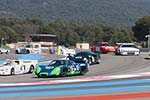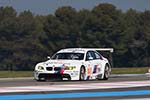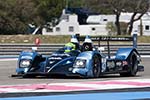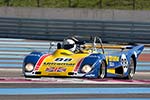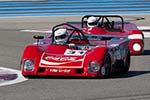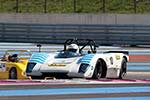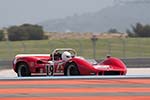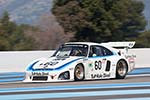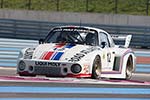
| Click here to save all images | Le Mans Series Castellet 8 Hours |
| | 2010 | |
 Sports car racing has survived the recent economic perils surprisingly well. This was underlined at the 2010 Le Mans Series season opener at the Le Castellet or Paul Ricard track. A commendable 41 cars lined up for the first ever Le Mans Series race at the track that is usually only used for testing. Even more importantly; nearly a dozen major manufacturers fielded or at least backed entries.
Sports car racing has survived the recent economic perils surprisingly well. This was underlined at the 2010 Le Mans Series season opener at the Le Castellet or Paul Ricard track. A commendable 41 cars lined up for the first ever Le Mans Series race at the track that is usually only used for testing. Even more importantly; nearly a dozen major manufacturers fielded or at least backed entries. One of the biggest contributing factors is the relatively stable set of regulations. For 2010 some changes to the prototypes were nevertheless required, particularly in the area behind the rear wheels. Some cars were affected more than others but none more than Audi's controversial R15. Its revolutionary concept of air running through the car was no longer possible. This forced the German team to completely redesign the V10 engined machine. Dubbed the R15 plus, the much more conventional but still rather odd looking LMP1 prototype made its debut at Le Castellet.
Now known as the HPD ARX-01c, the highly successful Acura LMP2 car was entered for its first European race by the Strakka team after three seasons in the ALMS (American Le Mans Series). The HPD V8 also found its way into the back of the RML Lola coupe.
The GT2 ranks were reinforced by BMW's M3, fielded by the experienced Schnitzer team. Although it shares many components with the car used in the ALMS, it features a new specifications to comply with the ACO (Automobile Club de l'Ouest) regulations, which are interpreted more strictly on this side of the Atlantic.
Another addition for the new season is the Formula Le Mans class, open exclusively to the Oreca-Courage built, Corvette powered prototypes. Last year they competed in their own races but there were never enough entries to make these really interesting. Seven examples were entered for the 8 hour race.
Practice and qualifying
 From the minute the pitlane opened all eyes were on the new Audi, piloted this weekend by Allan McNish and Dindo Capello. Providing the performance benchmark for the German team was the Oreca entered Peugeot 908. The French manufacturer also supplied one of their quickest drivers, Stephane Sarrazin, to support Oreca regulars Olivier Panis and Nicolas Lapierre. In the first practice the spectacularly liveried 908 still set the pace but in the second and third session, it could no longer match the Audi's times. Despite an advantage of nearly a second in the final run, the Audi failed to clinch the pole after Lapierre pulled a startlingly quick lap out of the bag, beating the new car by nearly a four tenths.
From the minute the pitlane opened all eyes were on the new Audi, piloted this weekend by Allan McNish and Dindo Capello. Providing the performance benchmark for the German team was the Oreca entered Peugeot 908. The French manufacturer also supplied one of their quickest drivers, Stephane Sarrazin, to support Oreca regulars Olivier Panis and Nicolas Lapierre. In the first practice the spectacularly liveried 908 still set the pace but in the second and third session, it could no longer match the Audi's times. Despite an advantage of nearly a second in the final run, the Audi failed to clinch the pole after Lapierre pulled a startlingly quick lap out of the bag, beating the new car by nearly a four tenths.Behind the clash of the titans, Oreca's Oreca 01 impressed early on but was forced to play catch-up the whole weekend due to a gearbox failure. This allowed the Aston Martin engined Lola of the works team to set the third fastest time, well over a second behind the fastest of the two diesels.
In LMP2 the balance has been seriously upset by the arrival of the HPD, which, especially in the hands of Danny Watts, proved to be in a class of its own. In qualifying he was over 2 seconds faster than last year's champions Quifel-ASM with their Zytek 09SB. Mathieu Lahaye overcame engine woes during practice to set the third fastest time in the Oak Racing Pescarolo. Like the RML team, who were fourth fastest, the French squad had stepped away from the turbocharged AER 'four' that had proven so troublesome during the last season. Of the seven identical Formula Le Mans cars, the Edoardo Piscopo driven DAMS car clinched pole.
 After the withdrawal of the Atlas FX-Team Full Speed Saleen, the GT1 class was literally rendered a one horse race; the Saleen S7-R of Larbre. Despite a crash in the warm-up and a delayed start, the car made it to the finish, automatically taking class honours.
After the withdrawal of the Atlas FX-Team Full Speed Saleen, the GT1 class was literally rendered a one horse race; the Saleen S7-R of Larbre. Despite a crash in the warm-up and a delayed start, the car made it to the finish, automatically taking class honours.GT2 proved to be the closest of all classes with 13 high quality entries; six Ferraris, four Porsches and a single Aston Martin, BMW and Spyker. Each of the cars featured at least one very quick driver, which was reflected in the times. In qualifying the whole field was separated by just 1.7 seconds, which is quite remarkable considering the lap time of nearly 2 minutes. Even more remarkable was the pace of the BMW, or more accurately the lack thereof. The latest addition was the slowest of all GT2 cars. Former FIA GT champions AF Corse celebrated their entry into the Le Mans Series with a pole position ahead of the Felbermayr Porsche. The all-star AF Corse Ferrari, with Formula race winners Jean Alesi and Giancarlo Fisichella as well as FIA GT regular Toni Vilander on board, was fourth fastest.
Classic Endurance Racing (CER)
 Although it is a faint memory, we can still remember the CER field at Donnington in 2006; barely a dozen cars made it out for the race. The series for 1960s and 1970s sports racers has come a very long way since then and this year all five rounds have been oversubscribed. Three of these are part of the Le Mans Series support program (Le Castellet, Spa and Silverstone) with additional rounds at Monza in June and a season finale back at Le Castellet in October. No fewer than 63 cars were entered this weekend, ranging from Lola T70s to Porsche 935s and a host of Chevrons.
Although it is a faint memory, we can still remember the CER field at Donnington in 2006; barely a dozen cars made it out for the race. The series for 1960s and 1970s sports racers has come a very long way since then and this year all five rounds have been oversubscribed. Three of these are part of the Le Mans Series support program (Le Castellet, Spa and Silverstone) with additional rounds at Monza in June and a season finale back at Le Castellet in October. No fewer than 63 cars were entered this weekend, ranging from Lola T70s to Porsche 935s and a host of Chevrons.To the relieve of many drivers and mechanics, the CER event used a layout of the track that featured a chicane in the 1.2 km 'Mistral' straight. This meant that the classic machines did not come up to the very fast and tricky 'Signes' corner at terminal velocity and also prevented the engines from running at full throttle for such a long time. It also placed the less powerful and nimble Lolas and Chevrons in a position to challenge the bigger engined cars that normally have the advantage at Le Castellet.
 Defending champion Jean Marc Luco was back with his rare and very quick Porsche 936. He was joined by many familiar faces and cars but as always there were new additions to the grid. Olivier Cazalieres brought the unique Cosworth DFV-engined Duckhams, which was designed for Alain de Cadennet by Gordon Murray in 1972. Of similar vintage and specification is Carlos Barbot's Lola T280. Brought back to Europe after a lengthy spell in Japan, it was recently restored to full running order by Lola-expert Clive Robinson and was used for the first time by Barbot at Le Castellet. He was quick straight away and eventually finished 3rd overall.
Defending champion Jean Marc Luco was back with his rare and very quick Porsche 936. He was joined by many familiar faces and cars but as always there were new additions to the grid. Olivier Cazalieres brought the unique Cosworth DFV-engined Duckhams, which was designed for Alain de Cadennet by Gordon Murray in 1972. Of similar vintage and specification is Carlos Barbot's Lola T280. Brought back to Europe after a lengthy spell in Japan, it was recently restored to full running order by Lola-expert Clive Robinson and was used for the first time by Barbot at Le Castellet. He was quick straight away and eventually finished 3rd overall.The fastest time of the two qualifying sessions was set by Patrice Lafargue in his two-litre BMW engined Lola T298. After the start, he immediately grabbed the lead ahead of Luco in his Porsche 936. The Swiss driver managed to get ahead and also set the fastest lap but visibly struggled to keep this pace up for the entire hour. Lafargue was back in the lead after the mandatory stop and went on to take the first win of the year. In class P1 David Ferrer took top honours in his Lola T70 Spyder, GT2 was for Herve Regout in his Porsche 934 and Bernard Moreau drove his Porsche 911 RS to victory in the GT1 class.
The race
 We all expected Allan McNish to do what he does best; storm to the head of the field on the opening lap. He did manage to get by Sarrazin in the Peugeot but was in turn passed by Stefan Mucke in the works Lola-Aston. The natural order was returned a few laps later with the two diesels storming away. Superb in traffic, McNish gradually crept away from the Peugeot in his new Audi. The fight for the lead effectively ended during Oreca's first stop for fresh rubber. The on-board mounted jacks failed and the subsequent repair dropped the Peugeot a full 8 laps down the order. Despite losing its chief rival and holding a comfortable lead over the rest of the field, the two Audi drivers continued to push throughout the race. An absolutely trouble-free run saw the R15 plus take a debut victory with a margin of five laps over the second placed car. Considering its fastest lap was six tenths faster than the Peugeot's, it is safe to say that the Audi would have won even if the 908 had not ran into trouble.
We all expected Allan McNish to do what he does best; storm to the head of the field on the opening lap. He did manage to get by Sarrazin in the Peugeot but was in turn passed by Stefan Mucke in the works Lola-Aston. The natural order was returned a few laps later with the two diesels storming away. Superb in traffic, McNish gradually crept away from the Peugeot in his new Audi. The fight for the lead effectively ended during Oreca's first stop for fresh rubber. The on-board mounted jacks failed and the subsequent repair dropped the Peugeot a full 8 laps down the order. Despite losing its chief rival and holding a comfortable lead over the rest of the field, the two Audi drivers continued to push throughout the race. An absolutely trouble-free run saw the R15 plus take a debut victory with a margin of five laps over the second placed car. Considering its fastest lap was six tenths faster than the Peugeot's, it is safe to say that the Audi would have won even if the 908 had not ran into trouble. Consolidating its 'best of the rest' position, the Aston Martin Racing Lola managed to hold on to the second place throughout the race, despite a puncture early in the race. Third was for the #13 Rebellion Lola and for most of the race, it looked like the Oreca would clinch fourth place. Team principal Hugues de Chaunac had other ideas and called in the AIM-powered machine for two very lengthy and unnecessary pit-stops. This allowed the team's Peugeot to get ahead and score valuable points.
Consolidating its 'best of the rest' position, the Aston Martin Racing Lola managed to hold on to the second place throughout the race, despite a puncture early in the race. Third was for the #13 Rebellion Lola and for most of the race, it looked like the Oreca would clinch fourth place. Team principal Hugues de Chaunac had other ideas and called in the AIM-powered machine for two very lengthy and unnecessary pit-stops. This allowed the team's Peugeot to get ahead and score valuable points.Strakka's perfect weekend was rudely disturbed by bodywork damage; the legality structures behind the left rear wheel had come loose. The car was called in by the officials; the required repairs cost the HPD well over nine minutes. This left the OAK Racing team in a position of luxury with the two cars holding first and third. The lead car had been forced to start from the back of the field after an engine change had prevented it from participating in qualifying. The positions were far from secure as Strakka drivers Leventis, Kane and particularly Watts embarked on what would become the drive of the weekend. The at one point comfortable lead was annihilated at a stunning pace and in the final hour Watts was back on top. His fastest lap was almost three seconds faster than the best of its closest pursuers. For OAK Racing a second and fourth was nevertheless a very promising result. RML celebrated its return to form with a well deserved third. The Applewood Seven team clinched the first Formula Le Mans class win ahead of the first of two Hope Polevision Racing cars, while third was for the second DAMS entry.
 After a sparkling start, the GT2 battle quickly settled down. The Porsches proved more reliable, more frugal and quite surprisingly also just as quick as the more fragile Ferraris. During the opening stages, the race still seemed to go into Ferrari's direction but the lead was quickly taken over by the IMSA Performance and Felbermayr Porsches. Various reliability issues struck most of the fastest Ferraris and one by one they were forced to retire. Suspension problems also dropped the IMSA Porsche down the order, making life very easy for defending champions Marc Lieb and Richard Lietz in the Felbermayr 997 GT3 RSR. A strong run saw the BMW steadily work its way up to order, running as high as second at one point. Then the radiator was pierced by debris on the track and much time was lost in the pits. Sixth in class was a small consolation. The day ended perfectly for the Felbermayr team with a one-two finish in the most hotly disputed of all classes. Third was for the Alesi, Fisichella and Vilander Ferrari.
After a sparkling start, the GT2 battle quickly settled down. The Porsches proved more reliable, more frugal and quite surprisingly also just as quick as the more fragile Ferraris. During the opening stages, the race still seemed to go into Ferrari's direction but the lead was quickly taken over by the IMSA Performance and Felbermayr Porsches. Various reliability issues struck most of the fastest Ferraris and one by one they were forced to retire. Suspension problems also dropped the IMSA Porsche down the order, making life very easy for defending champions Marc Lieb and Richard Lietz in the Felbermayr 997 GT3 RSR. A strong run saw the BMW steadily work its way up to order, running as high as second at one point. Then the radiator was pierced by debris on the track and much time was lost in the pits. Sixth in class was a small consolation. The day ended perfectly for the Felbermayr team with a one-two finish in the most hotly disputed of all classes. Third was for the Alesi, Fisichella and Vilander Ferrari.Final thoughts
 Wether Peugeot's decision to limit their works presence at Paul Ricard to just one driver was wise remains to be seen. Audi's convincing victory here will certainly have boosted moral in the team and confirmed the R15 plus is quick and reliable straight out of the box. The real warm-up for the 24 Hours of Le Mans will be at the next Le Mans Series round at Spa where both rivals will field full squads of six cars. The other car of the weekend was however the HPD ARX-01c, which left its rivals well behind. It continued to surprise its drivers, who went through corners much faster than felt sensible only to find that the car could actually go even faster. The race also revealed that the Formula Le Mans cars could do with a little more power and slightly better rubber. In the current specification, they are about as fast as the GT2 cars on the straights, which makes lapping very difficult. All of this and much more can be seen in our exclusive 190-shot slideshow.
Wether Peugeot's decision to limit their works presence at Paul Ricard to just one driver was wise remains to be seen. Audi's convincing victory here will certainly have boosted moral in the team and confirmed the R15 plus is quick and reliable straight out of the box. The real warm-up for the 24 Hours of Le Mans will be at the next Le Mans Series round at Spa where both rivals will field full squads of six cars. The other car of the weekend was however the HPD ARX-01c, which left its rivals well behind. It continued to surprise its drivers, who went through corners much faster than felt sensible only to find that the car could actually go even faster. The race also revealed that the Formula Le Mans cars could do with a little more power and slightly better rubber. In the current specification, they are about as fast as the GT2 cars on the straights, which makes lapping very difficult. All of this and much more can be seen in our exclusive 190-shot slideshow.The Le Mans Series will continue on May 9th with at the spectacular Spa Francorchamps circuit. A field of well over 50 cars is expected to take part in the 1000 km race.
Related Articles
|
|
|||||||||||||||||||
|
|
|||||||||||||||||||
|
|
|||||||||||||||||||
|
|
|||||||||||||||||||
|
|
|||||||||||||||||||
|
|
|||||||||||||||||||
Report by Wouter Melissen and images by Wouter Melissen and Pieter Melissen for Ultimatecarpage.com. A special thanks to David Lord for lending us one of his cameras.
| All Cars - Contact us - Privacy Statement - Top | © 1998 - 2024 Ultimatecarpage.com |


